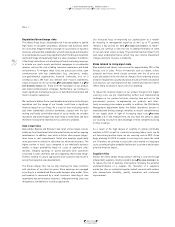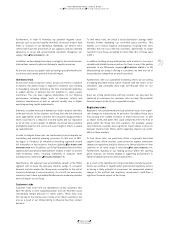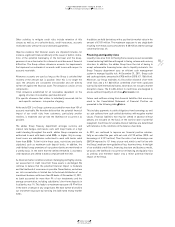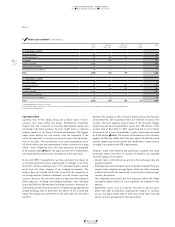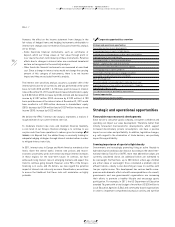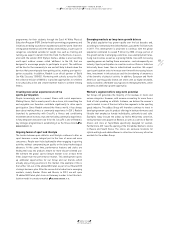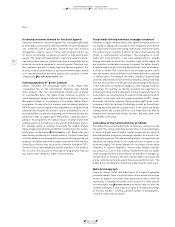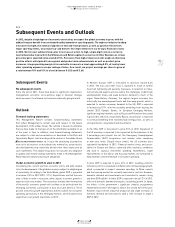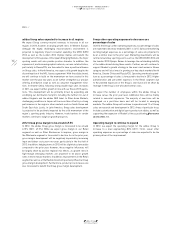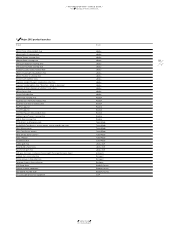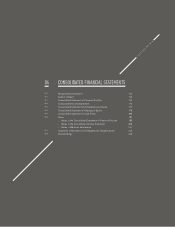Reebok 2011 Annual Report Download - page 164
Download and view the complete annual report
Please find page 164 of the 2011 Reebok annual report below. You can navigate through the pages in the report by either clicking on the pages listed below, or by using the keyword search tool below to find specific information within the annual report.
adidas Group
2011 Annual Report
GROUP MANAGEMENT REPORT – FINANCIAL REVIEW
160
2011
03.4 Risk and Opportunity Report Strategic and operational opportunities
03.4
Increasing consumer demand for functional apparel
Consumer demand for functional apparel has increased significantly
in recent years as consumers realise the benefits of functional apparel
over traditional cotton sportswear. Improved heat and moisture
management, superior ease of motion and increased comfort are
all factors encouraging consumers to switch to high-performance
apparel. The design and development of functional apparel requires
significantly more expertise, product and material research as well as
production know-how compared to low-tech apparel. Therefore, very
few companies are able to supply high-end functional apparel. Our
resources and our positioning as a sports performance leader enable
us to constantly develop innovative products and capitalise on them
commercially
SEE GLOBAL BRANDS STRATEGY, P. 68
.
Growing popularity of “green” products
Today’s consumers are increasingly aware of the impact their
consumption has on the environment. Therefore, they demand
more products that are environmentally benign and produced
on a sustainable basis. The adidas Group continues its efforts to
create meaningful product platforms that drive growth in this area.
We remain focused on the extension of the adidas ”Better Place”
programme, for which the first products were introduced globally in
2009. Products and packaging in the programme are designed taking
sustainability principles into account, such as broadening the use of
recycled materials and monitoring energy use in material and product
preparation. With all adidas Sport Performance categories partici-
pating in the programme, the adidas Group is moving forward with
ambitious plans in the build-up to the London 2012 Olympic Games.
For example, adidas is working closely with the London Olympic
Games Organising Committee (LOCOG) in contributing to the sustain-
ability goals of the Games
SEE SUSTAINABILITY, P. 107
. Reebok has also
been steadily introducing eco-friendly products. The Kids’ Green Easy
collection addresses environmental concerns by utilising recycled raw
materials for toddler and infant footwear. Launched in 2010, the Kids’
Green Easy collection was successfully continued throughout 2011.
Our efforts to use environmentally friendly materials in our products
are, of course, not exclusive to these specific programmes, they are
also used in other categories, albeit to a lesser extent.
Social media offering new ways to engage consumers
Advances in digital communication offer significant opportunities for
our brands to engage with consumers more frequently, and enhance
our opportunity to build long-lasting relationships and brand loyalty.
The adidas Group constantly monitors the latest developments and
trends in communication technologies. The emergence of social
media and social networks is one such example which is already
helping our brands increase their consumer reach. In this regard, we
are investing considerable resources to present the adidas Group’s
brands through a variety of social media platforms, such as Facebook,
YouTube or Twitter. This is reflected in our far higher growth rate of
fans and viewers on these different social media platforms compared
to industry peers. For example, the adidas Originals Facebook page
alone has attracted more than 12 million followers, adding more than
5 million fans over the 12-month period. A key advantage of these tools
is that they allow our brands to engage in a direct dialogue with our
consumers. For example, by offering consumers the opportunity to
actively participate in brand campaigns or in the design and creation of
new products, we can generate a far superior brand experience which
resonates in particular with the young generation. In 2011, adidas
also made substantial progress offering mobile applications to our
consumers. Both the miCoach Football app as well as the miCoach
Running app allow athletes to upload stats to the interactive adidas
training system and to share stats via social media. Data can then be
analysed and compared with friends, followers, and even some of the
top athletes in the world.
Leveraging strong market positions worldwide
The adidas Group is the market leader in numerous countries around
the world. This strong competitive position offers us many advantages
in terms of global brand visibility, market power and the ability to
effectively expand our position in emerging markets. As a result of our
strong partnership portfolio and marketing efforts, consumers around
the globe are highly aware of our brands and are receptive to our
brand messaging. This makes demand for our products more stable
compared to smaller competitors. Hence, many retailers consider
our products as core to their offering. Furthermore, with our global
retail coverage and distribution network, we are able to leverage our
infrastructure to introduce and more rapidly expand our brands and
product offerings to markets where they previously did not exist. The
adidas Group can therefore compete more effectively for retail space.
Multi-brand approach
Given the diverse tastes and expectations of a highly fragmented
consumer market, there is a natural limit to the audience size a single
brand can appeal to. Our multi-brand approach provides us with the
opportunity to leverage the power of our brands in a more precise
and meaningful way
SEE GROUP STRATEGY, P. 60
. We are able to utilise the
combined strengths of each brand to compete for a higher percentage
of the total market – covering a greater number of demographics,
consumer needs and price points.


